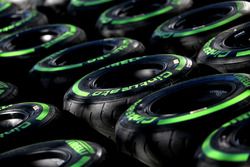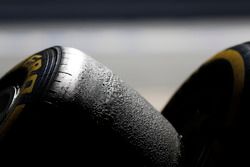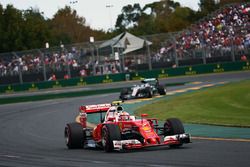Analysis: How Mercedes turned the tables on Ferrari
Formula 1 kicked off its 2016 season with a bang in Melbourne. Adam Cooper takes us inside the Australian Grand Prix.

Photo by: XPB Images












































The Australian GP proved to be a thoroughly entertaining race, one that the sport badly needed after the farce that was qualifying.
Fortunately, other 2016 F1 rule changes or clarifications played a more successful role in how Sunday played out, and in the end we saw a fascinating strategic contest unfold between Mercedes and Ferrari, with fortune seemingly favouring one then the other from the very start of the race.
New rules for this year require one rather than two clutch paddles, and with radio chat also cut back these days, drivers have to manage these revised systems on their own.
Things were further complicated in Melbourne when Dany Kvyat triggered an aborted start, so everyone had to go around again and manage temperatures and settings and so on.
From pole Hamilton got away badly. "There's not some single disaster that went on that we need to go analyse,” Paddy Lowe told Motorsport.com.
“I think it was probably a number of things combining to create some fairly poor starts. You have to say the objective of the regulation change, or reinterpretation in fact, is to make the starts more variable.
"And that's what we've seen [in the race]. So that was something that was well considered in advance.”
“In the way we measure [Lewis'] was a couple of metres worse than Nico after 100 metres,” said Toto Wolff.
“I'm not quite sure whether it was a software problem or hardware problem or a slow reaction, we just have to look into things. Yesterday our practice starts weren't very good. So we were not quite sure whether this would cause a problem in the race or not.
“[The radio ban] certainly plays a role because in the past if you would have a bad start off the line for the formation lap you can see how much the slip was, and if you can't adjust it makes a difference.”
Rosberg had no complaints about his own start – he passed Lewis after all – and yet ultimately he lost out to both Vettel and Raikkonen. One Ferrari source told me that the Italian team knows it has very effective start procedure for this year's single paddle rules.
Indeed, that may help to explain what happened in qualifying, when both drivers opted to save a set of supersoft tyres by not going for a second run in Q3.
In other words it could be that the team was confident that from the second row it still had a pretty good chance of getting in front, so rather than throw away a set of tyres trying to beat out the Mercs in qualifying, it was worth holding on to them.
Thereafter the red cars led in confident style, helped by the fact that Hamilton has lost out to a couple of other cars at the start, and got bogged down. Then at the stops Rosberg got ahead of Raikkonen for second, and gave himself a clear shot at Vettel.
Nevertheless a third of the way into the race it looked as though Seb, now four second ahead, really could win it. “The start was super,” said Maurizio Arrivabene.
“I have to say both of the drivers, they start like two rockets and after that they were able to take an advantage, and that was good for us.
"This is the reason why at a certain point we were looking at the gap, looking at our strategy prediction, and looking quite comfortable...”
Red flag stoppage
Then Fernando Alonso's accident brought out a red flag. It's something of an anomaly in the rules that under a race suspension drivers are allowed to make a free tyre change.
It's logical under safety grounds, given that by definition a red flag probably means that cars have passed through a debris field, but it can turn races around – in the case of the 2011 Monaco GP it completely ruined what was going to be a grandstand finish between cars on different strategies.
This time around it didn't do that, but it certainly turned things on their head. Rather handily we were now in the window to put on mediums and get to the flag without a further stop.
Indeed the first man to indicate that it was possible was none other than Hamilton, who came in on lap 16. It was a logical move for him given that he was out of position and had lost time getting past other cars.
Others to make the same move just before the stoppage were Nico Hulkenberg, Sergio Perez, Valtteri Bottas and Kevin Magnussen, so four teams figured it was possible.
Thus going to mediums under the red flag seemed like an entirely logical choice, unless there were specific strategic reasons to do something else. As always its much harder to get it right if you are at the sharp end and fighting for the win.
The other thing to remember is that you don't know what rivals are going to do – you only find out when the blankets come off just before the race resumes, and it's too late to react.
Mercedes decided to leave Hamilton on his nearly new mediums and give Rosberg the new set he had on hand. With Friday's rain restricting dry running and three tyres in play this year the team didn't know quite what to expect.
“With the one-stop [from the red flag] strategy we knew that it could come towards us,” said Wolff.
“We didn't have a lot of information about the medium, relying on last year's assumptions and what we've seen at the test, so it was good that we ran the medium a lot. It looked like it could last, we could survive, we could make it last.”
As Wolff notes Mercedes spent the vast majority of the Barcelona test on the medium, and was not short of data about how it might behave, even it wasn't specific to Melbourne 2016.
Lowe acknowledged that the testing had helped: “A little bit, yeah, and just general knowledge from running the medium last year. You wouldn't expect that data to be wrong a year later.”
Tyre poker
What Mercedes didn't know until others revealed their hands was what rivals would do. And when the blankets came off the Ferraris, both drivers were still on supersofts, and thus clearly committed to doing another stop.
Daniel Ricciardo and the two Toro Rosso drivers also ignored the medium to go with new softs. “Potentially the red flag was a real disaster for us,” said Lowe.
“Because it locked in a certain order from our position, that in our view you could finish on a single medium.
"Of course, it wasn't a complete no-brainer decision, but we thought that all the cars around us would go that way. We'd seen in the early part of the race that it was very, very difficult to overtake, even with a pace advantage," he continued.
“We were quite pleasantly surprised to see all the softs around us, and all the mediums behind, when the blankets came off. Not that it said that we were immediately going to drop into a one-two, but at least it gave us some hope, rather than no hope!”
So did the Ferrari choice come as a total surprise?: “We hadn't ruled it out, but it wasn't what we thought they would do...”
“The easier call was for Lewis,” said Wolff. “Because we knew the cars in front of him, Sainz, Verstappen and Ricciardo, that he wouldn't be able to overtake them on track. We saw how difficult it was with Verstappen before, so the one-stop was pretty obvious.
“Even though that's not the race that suits Lewis best, he likes to attack and have a tyre that makes it possible.
"For Nico it was the more difficult call up front, to decide do we want to make it a defensive strategy, and stick on the one-stop, or make him compete with the other guys in front on the same tyre.”
Rosberg agreed that as the team at the head of the field, Ferrari had a difficult decision to make when it came to rejecting mediums.
“It was the plan for him [Lewis] and it was the plan for me, in that sense as in where we were for that time in the race – because we had prepared those sorts of scenarios. But definitely the red flag, we used that perfectly going onto the medium," the German said.
“And the challenge is you don't know what the others are putting on, and Ferrari doesn't know what I'm putting on. I could've been putting on supersofts and just trying to attack, to overtake them.
"So they need to defend that a little with supersofts. It was a little bit of a gamble, a poker game. And we came out on top...”
Indeed one of the driving factors for Ferrari could have been exactly that, the fear that on mediums Vettel would have been vulnerable to attack either if a) Mercedes started on supersofts or b) both teams started on mediums and Mercedes didn't take as long to warm the tyres up.
Equally once the divergent tyre choice was clear Mercedes was concerned that Rosberg on mediums would struggle to get up to speed, and be jumped by Raikkonen.
That didn't happen, and against expectations he also managed to keep in touch with Vettel up ahead. “We thought the big fear would be the warm-up on the first lap,” said Lowe.
“And therefore once we got Nico through that first lap without losing a position to Raikkonen, we were very happy with that. And also that Nico could broadly maintain position with Sebastian.”
After the headache of the red flag Ferrari's day became a little worse when Kimi retired, and it was soon apparent that Vettel did not have the pace to open up a big enough gap to threaten Mercedes.
Even with a stop the final 39 laps split between his already used supersofts and a new set of softs for the run to the flag was a bit of a stretch, and he had to manage his pace.
“I was surprised, yes, but it was easy to explain,” said Rosberg. “He needed to get to the end of the race with just one more pit stop with 40-odd laps with supersoft and soft.
"He was managing his pace, he wasn't pushing on the supersoft. And I could push on the medium because I know that it would last.
"He needed to have a decent stint length, you can't push flat out, you need to manage it with the supersoft, so that's the explanation for that. But yes, I was surprised at the time.”
It wasn't all that straightforward for the Brackley camp either as the drivers still had to keep their mediums in good shape.
“It was just the unknown,” says Lowe. “Would the medium go that long? Because they were clearly pushing as hard as they could.”
Rosberg's brake issue
Then just to add to the challenge Rosberg hit some brake problems. “We suffered some little drama as well,” said Wolff.
“We had a problem on Nico's car with brake caliper temperatures which kept creeping up, almost to a stage where we thought about retiring the car.
"That was two-thirds into the race, and then it stabilised at maximum value. It was debris we caught in the caliper. And then it started to creep down again, very slowly, and recovered.
"At a certain stage it was very difficult for the team to handle. [Nico] didn't know. You can't tell him.”
There was no radio chat, but Rosberg did get a warning on his dash. He'd done his homework and was able to react to it.
As Lowe noted: “He just had one of his rear callipers that got a little bit out of control, but he did the right things to save the brakes with how it works now.”
The drama wasn't over, because in the late stages those medium tyres became an issue. Getting them to the flag while running flat out wasn't so straightforward after all.
“Fifteen laps to the end, our calculations showed that the tyre wouldn't last,” said Wolff. “And that around five laps to the end, the left rear could fall off the cliff.
"And the temperatures kept dropping and dropping and dropping every single lap. Our tyre guy said, 'Five laps to the end, that's it'.
“And you couldn't really stop them or tell them to go slower, because then that would have made the tyre temperatures fall even more.
"We lost a lot of grip on the rear left, but it is just one of four tyres, and we made it survive, made it last, until the end. It was really difficult, because we couldn't tell him to look after the left rear.
"If after all these years you're used to transmitting all this information to the driver, and optimise the car and also make the car survive, that lack of communication is definitely going to lead to situations which are beyond the engineer's control.
“We can tell them to push or not push,” says Lowe. “But as you saw it was not a situation to tell them to not push, particularly on Lewis's side!”
Hamilton did well to keep Vettel behind, and the situation resolved itself when the German ran wide at the penultimate corner with a couple of laps to go, as Paddy admits: “The tension went out of it at that point...”
Wrong call from Ferrari?
Would Vettel have won had he too gone onto mediums at the red flag? It's a debate that started even before the chequered flag.
“In front of everybody that we were showing a very, very good pace,” said Arrivabene. “We were quite comfortable and after the red flag, we took a decision. A certain decision that can be right or wrong...”
The consensus is that Ferrari did indeed miss a trick, but there is no definitive answer. As we've seen when you don't know what your rival will do the choice is not easy.
It could well be that if both teams took the restart on mediums they would have proved better suited to Mercedes, at the start and end of the stint for example, and Rosberg would have won anyway.
The more intriguing question is what might have happened without the red flag, and that's also far from clear. “I don't know,” Wolff admitted.
“Clearly the medium tyre after the restart was the key to the victory. We were actually quite surprised about the tyre choices of the others, and I must say that [strategy expert] James [Vowles] and his team have done a really awesome job of making the right calls at the right time.”
One thing is clear. The powers that be may have screwed up qualifying, but the decision to bring three compounds to each race has added an extra dimension.
One that could make many of this year's races far more interesting than they have been in the past. Lowe certainly believes that will be the case.
“Having three compounds in the race, which was a change we promoted from the middle of last year as being something that would add uncertainty and excitement to the race, I think we've seen that play out really well.”
Be part of Motorsport community
Join the conversationShare Or Save This Story
Subscribe and access Motorsport.com with your ad-blocker.
From Formula 1 to MotoGP we report straight from the paddock because we love our sport, just like you. In order to keep delivering our expert journalism, our website uses advertising. Still, we want to give you the opportunity to enjoy an ad-free and tracker-free website and to continue using your adblocker.























Top Comments